
 |
Tea Clipper |
 |
| from TeaAntiques.com | ||
| Edition Fifty Six |
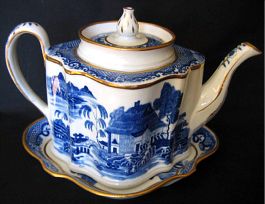 My
Featured Antique for July is a rare and charming New Hall teapot. It comes
complete with its original stand,
both the teapot and stand are beautifully decorated with a blue and white print known as the 'Trench Mortar' pattern.
My
Featured Antique for July is a rare and charming New Hall teapot. It comes
complete with its original stand,
both the teapot and stand are beautifully decorated with a blue and white print known as the 'Trench Mortar' pattern.
The teapot and stand are of a shape called silver shape, it copying silver teapot shapes of the period. It was made at the famous New Hall factory c1795 and is a very fine quality example.
The teapot has the same 'Trench Mortar' pattern in blue and white on both sides of its body. This attractive oriental scene shows a beautiful thatched bamboo house in a landscape of trees and mountains.
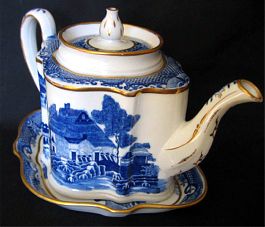
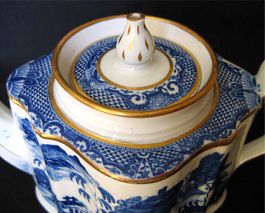
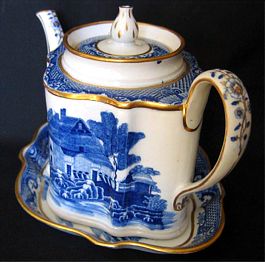
There is a circular galleried collar in which the circular lid fits, a typical New Hall feature. This preventing the lid from falling off when pouring tea. The flat shoulder of the teapot is decorated with a full oriental designed band of blue and white decoration.
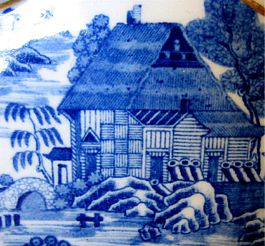
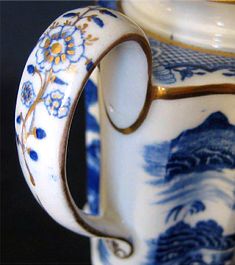
The same blue and white band of decoration that is on the teapot's shoulder, runs round the teapot's lid. There is the stylistic New Hall bud finial to the lid. The raised collar of the teapot and the lid finial and rim are embellished with gilt decoration.
The shape of the teapot stand is an exact match to the shape of the teapot. It is decorated in just the same way as the teapot with the print in blue and white of the 'Trench Mortar pattern.
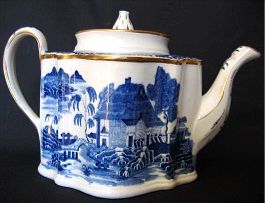
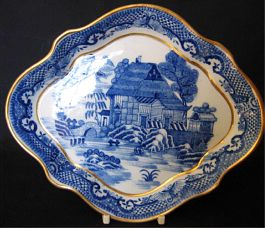
This beautiful teapot and stand are fine examples for the collector of English or New Hall porcelain.
More details of this item and other tea related antiques can be found by visiting my web site at www.TeaAntiques.com.
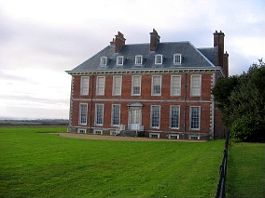 In
November 2004, I attended a Tea and Coffee master class, hosted by the National
Trust at the beautiful Uppark House in West Sussex, Southern England. The event
was presented by the renowned tea and coffee company Taylors of Harrogate and
Betty's Tea rooms. Betty's tea rooms are extremely popular venues for the
perfect afternoon tea, exquisitely served and with a choice of fine teas coffees
and cakes. Taylor' of Harrogate are a family of tea merchants established in
1886.
In
November 2004, I attended a Tea and Coffee master class, hosted by the National
Trust at the beautiful Uppark House in West Sussex, Southern England. The event
was presented by the renowned tea and coffee company Taylors of Harrogate and
Betty's Tea rooms. Betty's tea rooms are extremely popular venues for the
perfect afternoon tea, exquisitely served and with a choice of fine teas coffees
and cakes. Taylor' of Harrogate are a family of tea merchants established in
1886.
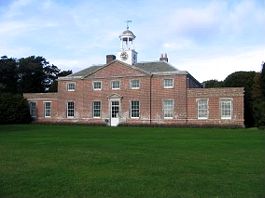 The
event was held in what was the original early Georgian kitchen block set back to
one side of the stunning red brick mansion. There were two young ladies from
Taylors of Harrogate who were experts in the field of teas and coffees. Shonar
is the marketing manager for the company and Fiona one of three tea buyers,
buying teas from tea plantations around the world.
The
event was held in what was the original early Georgian kitchen block set back to
one side of the stunning red brick mansion. There were two young ladies from
Taylors of Harrogate who were experts in the field of teas and coffees. Shonar
is the marketing manager for the company and Fiona one of three tea buyers,
buying teas from tea plantations around the world.
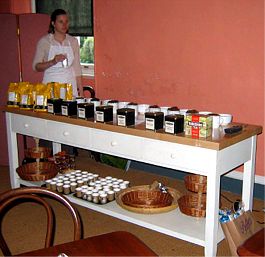 Fiona
explained her background and training in the world of the tea trade. She comes
from three generations of tea growers and was brought up on her father's tea
plantation in Kenya. After studying at university, she decided to join Taylors
of Harrogate as an apprentice tea taster / buyer. It takes between 3 and 5 years
to train as a taster / buyer. Her first part of the training was to
prepare hundreds of teas ready for tasting, every day 400- 600 teas would be
prepared and tasted. This tea making and tasting process is known as 'tea
bashing'.
Fiona
explained her background and training in the world of the tea trade. She comes
from three generations of tea growers and was brought up on her father's tea
plantation in Kenya. After studying at university, she decided to join Taylors
of Harrogate as an apprentice tea taster / buyer. It takes between 3 and 5 years
to train as a taster / buyer. Her first part of the training was to
prepare hundreds of teas ready for tasting, every day 400- 600 teas would be
prepared and tasted. This tea making and tasting process is known as 'tea
bashing'.
The tea tasting process is very tightly controlled to ensure accuracy and perfection, as the selection of teas is of the utmost importance when teas are bought; they are expensive and to make a mistake could be costly to the company and could result in an inferior tea. There are special white porcelain tea tasting covered cups, which sit in a white china bowl. There is a serrated pouring edge to the cup used to pour and strain the tea into the bowls before the tasting process.
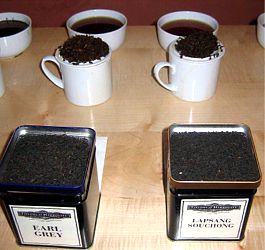
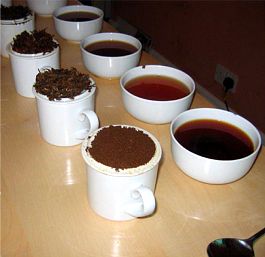
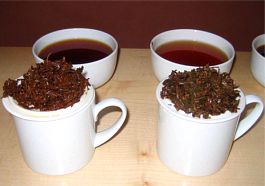 In
preparing for a tea tasting, an exact measure of 5½ grams of tea is put into the
individual cups. The reason that the measure of tea is 5½ grams is that this is
equivalent to the old penny weight of tea. Boiling water is then poured onto the
tea in each tea cup, the cover replaced and then it is left to brew for a
precise 5½ minutes. After this set time for brewing, the cup with its lid held
firm is turned onto its side and placed onto the bowl to allow the tea to drain
out into the tasting bowl. The cups are then taken out, placed in front of the
bowls and the tea leaves emptied into the inverted cup lid which is then placed
on top of the empty cup. The reason for displaying the brewed tea leaves is that
the taster can see the colour of the leaves, which should appear a coppery brown
colour, too green and the tea will not keep for long in storage.
In
preparing for a tea tasting, an exact measure of 5½ grams of tea is put into the
individual cups. The reason that the measure of tea is 5½ grams is that this is
equivalent to the old penny weight of tea. Boiling water is then poured onto the
tea in each tea cup, the cover replaced and then it is left to brew for a
precise 5½ minutes. After this set time for brewing, the cup with its lid held
firm is turned onto its side and placed onto the bowl to allow the tea to drain
out into the tasting bowl. The cups are then taken out, placed in front of the
bowls and the tea leaves emptied into the inverted cup lid which is then placed
on top of the empty cup. The reason for displaying the brewed tea leaves is that
the taster can see the colour of the leaves, which should appear a coppery brown
colour, too green and the tea will not keep for long in storage.
It is important the the water used to make the tea is at boiling point, so as to get as much oxygen into the tea as possible to allow the maximum flavour to be released. Teas are tasted in batches of 90 in one go, first without milk and then again with full cream milk. Tasting without milk will give a taste of the pure tea, but tasting with milk will give the result that many customers will be tasting when making their tea and so it is important to make sure that it blends well with milk.
For the purpose of tea tasting, the tea samples are made at twice the strength that most people would make their tea at home. The tea is tasted by taking a soup shaped spoon and sucking it into the mouth noisily and then swirling it round to get to all the taste buds before spitting it out into a waste receptacle. Again, in sucking the tea into the mouth it ensure the maximum oxygen is mixed with the tea for maximum flavour.
Taylors of Harrogate do a blend of tea in tea bags called 'Yorkshire Tea'
using a blend of 30 different teas to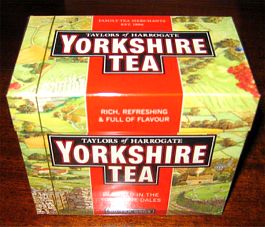 produce a strong full favoured tea. It is this tea that the National Trust use
in their tea shops as the standard house blend. There are two types of these tea
bags available, in an orange box for making tea in hard water areas and in a
green box for soft water areas. Hard and soft water can affect the taste of the
teas in different ways, so blends for each type are often produced or blends
specifically recommended.
produce a strong full favoured tea. It is this tea that the National Trust use
in their tea shops as the standard house blend. There are two types of these tea
bags available, in an orange box for making tea in hard water areas and in a
green box for soft water areas. Hard and soft water can affect the taste of the
teas in different ways, so blends for each type are often produced or blends
specifically recommended.
Tea trees will grow naturally to about 60 feet, so in the tea plantations they are kept pruned to a picking height. Pickers of tea are usually ladies, who carry baskets on their backs in which to put the plucked tea leaves. Many of the ladies are from generations of tea pickers. Only the top two leaves and bud are picked from the trees. The ladies are paid a basic wage and then a bonus for picking tea above and beyond their daily quota. A tea picker can pick about 80kg of tea per day. Tea plantations such as those in Shri Lanka are grown in hilly terrain, which is hot and humid. There are large trees planted between the tea trees that provide shade for the tea thus preventing the leaves getting scorched by the sun.
The time of tea harvesting varies around the world. In India it is harvested in the summer, but in plantations nearer the equator where the climate remains quite stable it can be harvested through out the year. In Darjeeling, the Darjeeling tea, known as the 'Champagne of teas', is harvested in the Spring when the young tea growth is fresh and at its best. The plantations in Darjeeling are in a beautiful mountainous setting and where there are often mists that descend over the plantations.
When the tea has been picked it is taken to a 'withering' factory, where the tea is 'fluffed up', by a man throwing it up into the air. This process separates the leaves and airiates the tea and takes about 12 hours. Hot air is blown up underneath the tea to remove the moisture if the tea is wet, ideally the moisture should be about 70 %.
There are then two basic ways that tea is manufactured. These are known as the orthodox method and C.T.C (cut, tear, curl). The orthodox method uses a rolling process on a rolling table with weights above. How much weight is applied determines the size of the resulting tea leaves. The C.T.C method is used for the fine tea leaves that go into the manufacture of tea bags. The resulting tea gives a quick, strong, beep coloured infusion that is ideally suited for tea bags.
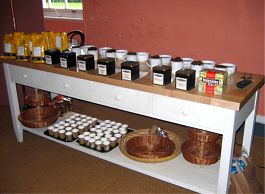 Teas are then fermented for oxidisation, for this the tea is kept at a
temperature of 37 degrees for about 1 hour and during this time the tea develops
into the brown colour that we know for tea. After this, it is put into an oven to
stop the fermentation process, which if continued would ruin the tea. When the
tea is removed from the oven, it has the aroma of toast or biscuits.
Teas are then fermented for oxidisation, for this the tea is kept at a
temperature of 37 degrees for about 1 hour and during this time the tea develops
into the brown colour that we know for tea. After this, it is put into an oven to
stop the fermentation process, which if continued would ruin the tea. When the
tea is removed from the oven, it has the aroma of toast or biscuits.
The teas are then graded into different grades by size of leaf using a sieve and then packed off to the tea auction houses. 6 million Kg of tea are auctioned every week! Taylors of Harrogate take only from the top 20% of the teas for their tea supplies, which is then shipped to the UK.
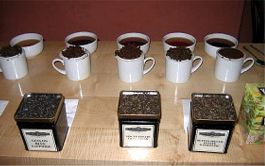 The
teas that were tasted during this master class were Betty's special estate
Darjeeling; Single estate tippy Assam, Ceylon blue sapphire; Jasmine green
China; Lapsang Souchong; Earl Grey and Yorkshire tea.
The
teas that were tasted during this master class were Betty's special estate
Darjeeling; Single estate tippy Assam, Ceylon blue sapphire; Jasmine green
China; Lapsang Souchong; Earl Grey and Yorkshire tea.
Tippy Assam - From West Bengal, this tea is grown at sea level. It is a tea with flavour that is an essential ingredient for the Yorkshire tea blend as it has good strength or 'guts' that the tea blend requires.
Darjeeling - This tea comes from the foot hills of the Himalayas where it is grown at high altitude - 7,000 - 9,000 feet up. Because of the high altitude, the tea is slow growing and so develops its mature flavour over a long period.
Betty's exclusive 'Blue Sapphire' blend - Flowery Broken Orange Pekoe (F.B.O.P). This is named from the fine blue sapphire gem stones found in the area. This is a tee with a toast and honey flavour about it, rather lighter than the Tippy Assam.
Jasmine green China - Green teas are harvested in Spring and as soon as it has been picked it is put through a machine to kill of the enzymes. It then goes through much the same processes the black teas. The tea is kept until the autumn when the Jasmine's are in full bloom and the open flowers are added to the tea to give it that characteristic flowery flavour and scent.
Lapsang Souchong - (referred to by Fiona as the 'marmite' of teas!). To produce this tea, wood fires are burnt under the factory, the smoke is then passed through the tea, giving it that smoky aroma when brewed. It is said that this tea was first invented accidentally, when some tea pickers on their way to market with their tea had camped overnight in the rain. Their tea got very wet, so they dried it out over the camp fires. As a result the tea took up the smoke flavour, which was an instant success with those buying the tea.
Earl Grey - A tea blend dedicated to Prime Minister Earl Grey, a tea flavoured with Bergamot Oil. Betty's use only natural bergamot oil in their Earl Grey, making it superior to many other blends which use artificial flavourings.
This tasting concluded the master class. Each person attending was presented upon leaving, a Betty's carrier bag containing some of their produce, included was a tin of English Breakfast tea; packet of Yorkshire tea bags; packet of Brazilian Bourbon Valley Coffee and a Yorkshire tea loaf - a fruit tea loaf made with Yorkshire tea. A generous gift ending a most interesting master class.
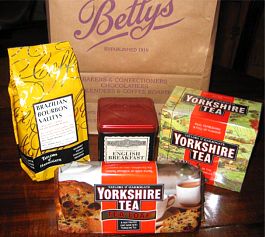
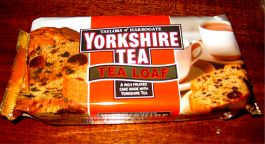
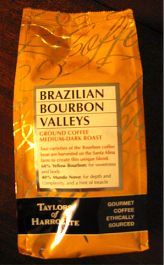
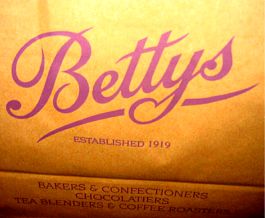 For
those interested in becoming a tea buyer / taster. It was interesting to hear
that there are only three buyers working for Taylors of Harrogate. During the
week, they are not permitted to drink alcohol, eat garlic, drink coffee or wear
perfumes!! This is because such things would affect their senses of taste and
smell during the tea tasting. However, the benefits must be to be able to travel
round the world to the tea plantations to buy the tea, all in the name of
providing us with that perfect cup of tea when ever we need one.
For
those interested in becoming a tea buyer / taster. It was interesting to hear
that there are only three buyers working for Taylors of Harrogate. During the
week, they are not permitted to drink alcohol, eat garlic, drink coffee or wear
perfumes!! This is because such things would affect their senses of taste and
smell during the tea tasting. However, the benefits must be to be able to travel
round the world to the tea plantations to buy the tea, all in the name of
providing us with that perfect cup of tea when ever we need one.
Click here for
Local Map
Map courtesy of www.streetmap.co.uk
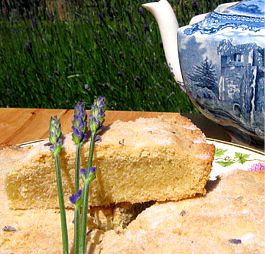 Now that summer has well and truly arrived, here is a lovely
twist to traditional shortbread - Lavender shortbread. This rich and crumbly tea time treat, is made with the addition of Lavender flavoured
sugar giving it a delicate flavour of this delightfully fragrant flower which is gracing many
gardens at this time of the year.
Now that summer has well and truly arrived, here is a lovely
twist to traditional shortbread - Lavender shortbread. This rich and crumbly tea time treat, is made with the addition of Lavender flavoured
sugar giving it a delicate flavour of this delightfully fragrant flower which is gracing many
gardens at this time of the year.
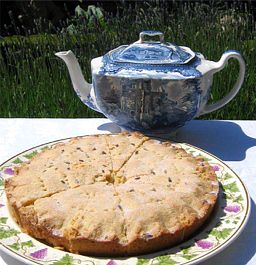
Lavender's bright blue flowers, when over, can be dried to produce dried flower buds later in the year. When added to sugar and left for some months will impart the flavour from the Lavender into the sugar. This sugar can be used to make the shortbread.
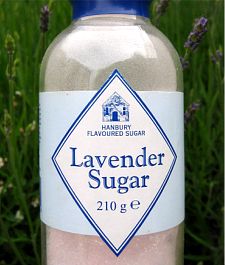
If you do not grow your own Lavender, then a Lavender flavoured sugar is commercially available. I used a brand of Lavender sugar from Hanbury to make a round of shortbread, which I then enjoyed sat in the garden with bees busy collecting the pollen from my own Lavender bushes.
For those who wish to try making some Lavender flavoured shortbread, here is the recipe:
8oz (225g) butter
2oz (50g) caster sugar
2oz (50g) Lavender flavoured sugar (plus a little extra for sprinkling onto the cooked shortbread)
10oz (275g) plain flour
2oz (50g) semolina
Method:
Pre-heat the oven to 170C, 325F or gas mark 3.
Place all the ingredients in a food processor and mix together for several minutes until fully combined into a sticky dough.
Grease an 8" sandwich tin with a little butter and empty the dough from the processor into the tin. Press the dough flat into the tin with your hand. 'Pinch-up' the edge to create a pretty pattern. Pick the surface of the shortbread all over with a fork which allows it to cook through evenly.
Place the sandwich tin into the centre of the oven and allow to cook for about 40 minutes, or until golden brown on the surface.
Remove the sandwich tin from the oven and allow the shortbread to cool in the tin. After cooling it for 5 minutes, sprinkle the shortbread with Lavender sugar and then cut the shortbread into wedges, leaving them in the tin to completely cool.
Once the shortbread has cooled completely in the tin, remove it and enjoy with your afternoon tea.
To review past newsletters, just follow this link:
Past newsletters.
To subscribe to this free newsletter -
Click here